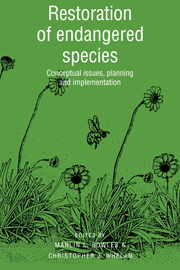Book contents
- Frontmatter
- Contents
- List of contributors
- Foreword
- Acknowledgments
- I Conceptual issues in restoration ecology
- II Restoration planning
- III Implemented restorations
- IV Synthesis and future directions: biology, politics and reality
- 14 Restoration ecology: living with the Prime Directive
- Taxonomic Index
- Subject Index
14 - Restoration ecology: living with the Prime Directive
Published online by Cambridge University Press: 27 January 2010
- Frontmatter
- Contents
- List of contributors
- Foreword
- Acknowledgments
- I Conceptual issues in restoration ecology
- II Restoration planning
- III Implemented restorations
- IV Synthesis and future directions: biology, politics and reality
- 14 Restoration ecology: living with the Prime Directive
- Taxonomic Index
- Subject Index
Summary
Introduction
In the television series Star Trek, the starship Enterprise warps around galaxies exploring new worlds and seeking out new intelligent life forms. The Prime Directive provides a guiding principle, dictating that the starship's crew must not interfere with the machinations, politics, cultures, or lifestyles of the various aliens found on distant planets. This ‘look but don't touch’ philosophy embeded in the Prime Directive provides moral backbone and ample opportunities for ethical dilemmas as the crew of the Enterprise find themselves crossing the line from observer to meddler in the affairs of other galactic organisms. This same dilemma characterizes our present relationship with nature. At once, we perceive ourselves as product, beneficiary, caretaker, trespasser, and vandal of the earth's evolutionary ecology.
On the one hand, we feel obliged to compete with, prey upon, and make war on the villainous, yet vibrant, components of our ecology. Few speak of preserves or restoration projects for mosquitoes, human parasites, Norway rats, or numerous species of household commensals. In times past, we celebrated the eradication of wolves, much as today we celebrate successful extirpations of tsetse flies or smallpox. On the other hand, we sanctify other species whose niches we have swept away, or those species posing little threat to our livelihoods. As each population of rhinoceros, honey creeper, or Monarch butterfly disappears, we perceive a vanishing Garden of Eden. While we strive for the extermination of that biodiversity labeled as pests, we generally view as calamitous the present rates and trends of species extinction. We seek a diverse yet kinder, gentler nature.
- Type
- Chapter
- Information
- Restoration of Endangered SpeciesConceptual Issues, Planning and Implementation, pp. 355 - 380Publisher: Cambridge University PressPrint publication year: 1994
- 7
- Cited by



